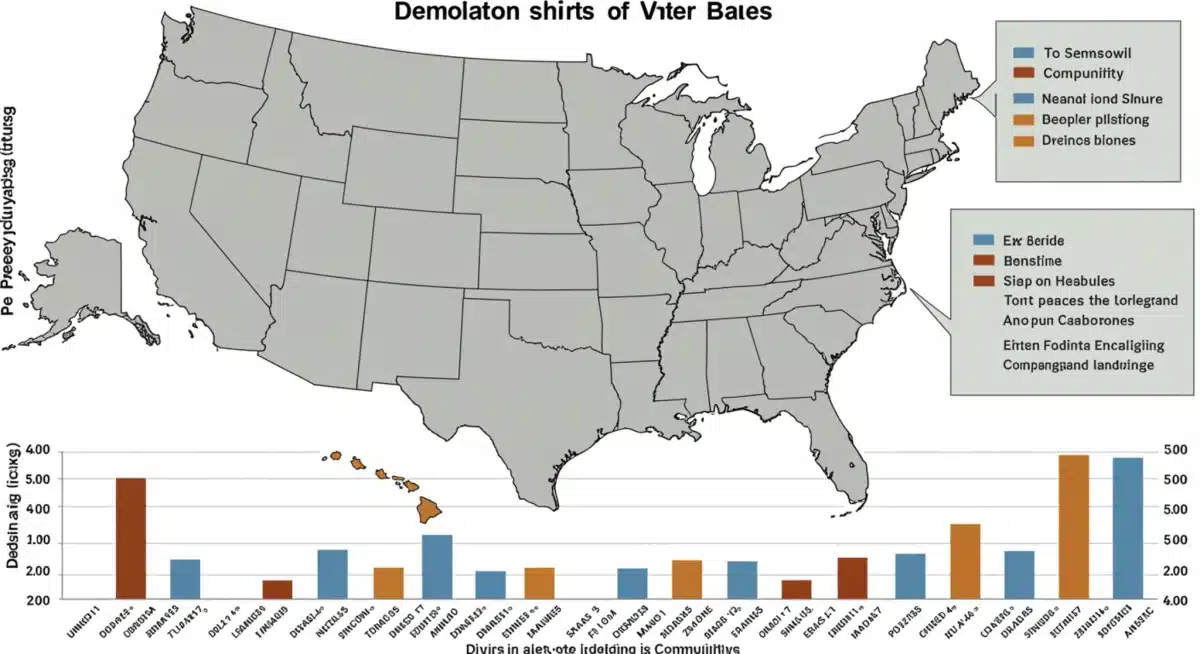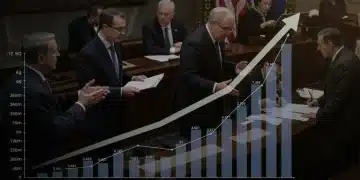Affirmative Action Decision: Impact on Future Political Leadership

The Supreme Court’s decision on affirmative action is poised to significantly reshape the landscape of future political leadership, influencing candidate pools, policy debates, and the fundamental composition of governing bodies across the United States.
The Supreme Court’s recent ruling on affirmative action has ignited a nationwide debate, with profound implications that extend far beyond college admissions. The central question many are asking is, How Could the Supreme Court’s Decision on Affirmative Action Impact Future Political Leadership? This landmark decision is not merely about who gets into universities; it’s about shaping the pipeline for future leaders, influencing everything from corporate boardrooms to legislative chambers and the very fabric of American governance.
Understanding the Affirmative Action Ruling and Its Immediate Effects
The Supreme Court’s decision on affirmative action effectively ended race-conscious admissions practices in higher education. This ruling, rooted in the Equal Protection Clause of the 14th Amendment, asserted that such practices were unconstitutional. While the immediate focus was on universities, the ripple effects are expected to permeate various sectors, including the pathways to political power.
Historically, affirmative action aimed to address systemic inequalities and foster diversity in institutions that have historically excluded minority groups. Proponents argued it was essential for creating a more representative society and ensuring equal opportunity. Opponents, however, contended that it led to reverse discrimination and that admissions should be based solely on merit, without considering race.
Shifting the Educational Landscape
The most direct impact of the ruling is on college and university admissions. Institutions are now re-evaluating their policies to comply with the new legal framework. This means a greater emphasis on race-neutral criteria, which could alter the demographic composition of student bodies.
- Reduced Diversity: Studies in states with prior affirmative action bans suggest a decrease in minority student enrollment at highly selective institutions. This trend could now become national.
- Altered Pathways: Students from underrepresented backgrounds may find it harder to access elite universities, which have historically served as launching pads for political careers.
- New Strategies: Universities are exploring alternative methods to promote diversity, such as focusing on socioeconomic status, geographic origin, or first-generation college student status, though their effectiveness remains to be seen.
The long-term consequences for the educational pipeline are complex. A less diverse university environment could mean a less diverse pool of graduates entering various professions, including law, public policy, and business, all of which are common precursors to political leadership. This initial shift could have a compounding effect over decades.
The Supreme Court’s decision marks a significant turning point, compelling institutions to rethink their approach to diversity. The immediate effects are undeniably centered on education, but these changes are merely the first domino in a potentially much larger chain reaction that will influence who rises to positions of power in the United States.
The Political Pipeline: From Academia to Public Office
The journey to political leadership often begins in academic institutions, particularly elite universities that cultivate intellectual talent and foster networks. These institutions have historically served as critical feeders for political careers, from law schools producing judges and legislators to public policy programs shaping future policymakers. The Supreme Court’s affirmative action ruling could fundamentally alter this pipeline.
If diversity decreases in top-tier universities, the pool of graduates from underrepresented groups pursuing careers in law, public administration, and other fields that often lead to political office may also shrink. This could result in a less diverse talent pool from which future political leaders are drawn, potentially exacerbating existing disparities in representation within government.

Consider the historical context: many prominent political figures, particularly those from minority backgrounds, have leveraged their education from prestigious institutions to build their careers. A restricted access point to these institutions could mean fewer such individuals emerge in the future. This isn’t just about optics; it’s about the lived experiences and perspectives that diverse leaders bring to policy-making and governance.
Impact on Professional Fields
Beyond direct political science or public policy degrees, many politicians come from legal backgrounds. Law schools, often directly influenced by the Supreme Court’s rulings, are also adjusting their admissions. A less diverse legal profession could lead to a less diverse judiciary and fewer lawyers entering politics.
- Legal Profession: Fewer minority students in top law schools could mean fewer minority lawyers, judges, and prosecutors, who often transition into political roles.
- Public Service: Graduate programs in public administration and policy may also see shifts, impacting the diversity of candidates for civil service and elected positions.
- Business and Entrepreneurship: While not a direct political pipeline, success in these areas often provides a platform for political aspirations. A less diverse educational base could indirectly affect this route as well.
The interconnectedness of education, professional development, and political aspirations means that changes at the foundational level of university admissions will inevitably reverberate through the entire system. Understanding this intricate web is crucial for anticipating how future political leadership will evolve. The composition of student bodies today will likely reflect the composition of governing bodies tomorrow, making this ruling a potent force in shaping the nation’s political trajectory.
Diversity in Governance: Representation and Policy Outcomes
The debate over diversity in political leadership is not merely about demographics; it’s about the quality of governance and the efficacy of policy-making. A diverse body of leaders is often seen as bringing a wider array of perspectives, experiences, and cultural understandings to the table, which can lead to more inclusive policies and better outcomes for all segments of society.
When political leadership lacks diversity, there’s a risk of policies being crafted without a full understanding of how they will impact various communities, particularly those that are underrepresented. This can lead to blind spots, unintended consequences, and a perception of illegitimacy among certain populations, further dividing the electorate. The Supreme Court’s decision could exacerbate these issues by potentially narrowing the pipeline of diverse candidates for elected and appointed positions.
The Argument for Representative Government
A core tenet of democratic governance is representation. When legislative bodies, executive offices, and the judiciary reflect the diversity of the populace, it enhances public trust and the legitimacy of government decisions. Conversely, a significant disparity in representation can lead to feelings of disenfranchisement and alienation among minority groups.
- Enhanced Legitimacy: Diverse leaders can foster greater trust and confidence in government institutions among a broader electorate.
- Broader Perspectives: Different backgrounds bring unique insights, leading to more comprehensive policy discussions and innovative solutions to complex societal problems.
- Improved Policy Outcomes: Policies developed with diverse input are often more equitable and effective in addressing the needs of a varied population.
The Supreme Court’s ruling could inadvertently create an environment where the path to political power becomes less accessible for individuals from certain racial and ethnic backgrounds. This could lead to a less representative political class, potentially impacting the types of legislation pursued, the priorities of government, and the overall direction of the country. The long-term implications for the perceived fairness and responsiveness of American democracy are substantial, and warrant careful consideration as the effects of the ruling unfold.
Electoral Strategies and Voter Engagement in a Post-Affirmative Action Era
The Supreme Court’s decision on affirmative action will undoubtedly force political parties and candidates to re-evaluate their electoral strategies and approaches to voter engagement. As the demographic landscape potentially shifts in higher education and subsequent professional fields, the pool of candidates for political office may also change, requiring parties to adapt how they identify, recruit, and support future leaders.
Moreover, the ruling itself is a potent political issue that could galvanize certain segments of the electorate while alienating others. How candidates articulate their stance on diversity, equity, and opportunity in the wake of this decision will be crucial in appealing to a diverse voter base. Parties will need to craft messages that resonate with voters who feel either vindicated or disenfranchised by the ruling.

Mobilizing Diverse Coalitions
For parties that have historically relied on diverse coalitions, the challenge will be to maintain and strengthen these alliances in an environment where racial considerations in admissions are curtailed. This might involve emphasizing socioeconomic factors, geographic diversity, or other race-neutral approaches to opportunity.
- Messaging Shift: Parties may pivot from race-conscious language to broader appeals emphasizing equal opportunity, social mobility, and addressing systemic barriers through other means.
- Grassroots Engagement: Increased investment in grassroots organizing and community outreach will be essential to connect with and mobilize diverse voters who may feel their interests are no longer prioritized.
- Candidate Recruitment: Parties will need to actively seek out and support diverse candidates through alternative pathways, such as community leadership, non-profit work, or local government, if traditional academic paths become less diverse.
The ruling could also lead to increased political activism and voter registration efforts among groups advocating for greater diversity and equity. This heightened engagement could reshape electoral outcomes, making it imperative for political campaigns to understand and adapt to these evolving dynamics. The future of political leadership will depend not only on who runs, but also on how effectively their campaigns connect with a changing electorate, navigating the complex implications of this landmark decision.
Policy Implications and Future Legislative Battles
The Supreme Court’s decision on affirmative action is far from the final word on diversity and equity in America. Instead, it is likely to ignite new legislative battles and policy debates at both federal and state levels. Political leaders will be pressured to respond to the ruling, either by seeking alternative ways to promote diversity or by solidifying the shift towards race-neutral approaches across various sectors.
This ruling will compel policymakers to consider how existing laws and regulations, particularly those related to employment, contracting, and other areas where diversity initiatives have been implemented, might be re-evaluated or challenged. The legal landscape surrounding diversity is now more complex, requiring careful navigation and potentially innovative legislative solutions.
Federal and State Responses
At the federal level, there could be attempts to pass legislation that either reinforces the spirit of affirmative action through race-neutral means or explicitly prohibits any consideration of race in government-funded programs. State legislatures, too, will likely become arenas for similar debates, with some states potentially moving to ban diversity, equity, and inclusion (DEI) initiatives more broadly, while others seek to protect or expand them through alternative means.
- Legislative Pushback: Advocates for diversity may push for legislation that promotes equity through socioeconomic factors, geographic diversity, or other non-racial criteria.
- Executive Orders: Presidents and governors might use executive orders to influence diversity policies within their respective administrations, though these would likely face legal challenges.
- Judicial Scrutiny: The ruling opens the door for increased legal challenges to diversity initiatives in other areas, such as corporate hiring practices or government contracting, leading to further judicial review.
The political ramifications extend to how political parties will position themselves on these issues. The decision could become a wedge issue, defining party platforms and influencing voter turnout. Future political leaders will need to articulate clear stances on diversity, opportunity, and the role of government in addressing historical inequalities, shaping the legislative agenda for years to come. This ruling marks a new chapter in the ongoing national conversation about race and equality, demanding sophisticated and nuanced policy responses.
Adapting to a New Era: The Long-Term Outlook for Leadership
The Supreme Court’s affirmative action decision ushers in a new era for American institutions, particularly concerning the pathways to leadership. The long-term outlook suggests a period of adaptation, innovation, and potential redefinition of how diversity is pursued and achieved. Political leaders, both current and aspiring, will need to navigate this evolving landscape with strategic foresight and a deep understanding of its multifaceted implications.
This isn’t merely about complying with a court ruling; it’s about understanding the societal shifts it may trigger. The decision could accelerate conversations about meritocracy, privilege, and access, pushing political discourse into new territories. Future leaders will be tasked with addressing these complex issues, finding common ground, and crafting solutions that resonate with a diverse and often divided populace.
Innovation in Talent Development
One significant long-term impact could be the emergence of new models for identifying and nurturing talent from underrepresented communities. If traditional pathways through elite universities become less diverse, alternative pipelines may gain prominence. This could include community colleges, vocational schools, or grassroots leadership programs that cultivate skills and experiences valuable for public service.
- Alternative Pathways: Increased focus on community-based leadership development programs, local government experience, and non-profit sector engagement as springboards to political careers.
- Mentorship and Sponsorship: Enhanced importance of mentorship and sponsorship programs to support individuals from underrepresented backgrounds in navigating professional and political spheres.
- Data-Driven Approaches: Greater reliance on data analytics to identify systemic barriers and measure the effectiveness of new diversity initiatives that are race-neutral.
The decision also highlights the enduring challenge of achieving genuine equality of opportunity. Future political leaders will need to grapple with how to foster a society where every individual has the chance to succeed, regardless of their background, without relying on race-conscious policies. This will require creativity, political will, and a sustained commitment to addressing the root causes of inequality. The long-term outlook points towards a more complex, but potentially more innovative, approach to cultivating the next generation of American leaders.
In conclusion, the Supreme Court’s affirmative action ruling is a monumental decision with far-reaching consequences for future political leadership. It will reshape educational pipelines, influence professional diversity, alter electoral strategies, and spark new legislative battles. The long-term impact demands a proactive and innovative approach from political leaders to ensure that American governance remains representative and effective in a continually evolving society.
| Key Impact Area | Brief Description |
|---|---|
| Educational Pipeline | Potential decrease in diversity at elite universities, impacting the pool of future leaders. |
| Political Representation | Risk of less diverse political bodies, affecting policy insights and public trust. |
| Electoral Strategies | Parties must adapt to changing voter demographics and messaging on diversity. |
| Policy Debates | New legislative battles and policy approaches to diversity and equity will emerge. |
Frequently Asked Questions About Affirmative Action and Political Leadership
The Supreme Court ruled that race-conscious admissions programs at universities were unconstitutional, violating the Equal Protection Clause of the 14th Amendment. This effectively ended the practice of considering race as a specific factor in college admissions, shifting focus to race-neutral criteria for diversity.
By potentially reducing diversity in elite educational institutions, which are common feeders for political careers, the ruling could lead to a less diverse pool of graduates entering fields like law and public policy. This might, in turn, result in fewer diverse candidates for elected and appointed offices over time.
Yes, political parties will likely need to adapt. They may shift messaging from race-conscious appeals to broader themes of equal opportunity and socioeconomic mobility. Additionally, increased grassroots efforts and a focus on recruiting diverse candidates through alternative pathways are anticipated to maintain voter engagement and coalition strength.
The decision is expected to spark new legislative debates. There could be attempts to pass laws reinforcing race-neutral diversity approaches or, conversely, to challenge existing DEI initiatives in other sectors. Executive orders and further judicial scrutiny of diversity programs are also likely outcomes.
Institutions and leaders can explore race-neutral methods like focusing on socioeconomic status, first-generation college student status, or geographic diversity. Developing alternative talent pipelines, enhancing mentorship programs, and utilizing data-driven approaches to identify and address systemic barriers are also crucial strategies for fostering diversity.
Conclusion
The Supreme Court’s decision on affirmative action represents a pivotal moment with substantial and enduring implications for the trajectory of American political leadership. While directly targeting university admissions, its ripple effects are poised to reshape the very foundations of the political pipeline, influencing who gains access to crucial educational and professional opportunities. This shift will undoubtedly challenge political parties to innovate their electoral strategies, compel policymakers to navigate new legislative terrains, and ultimately redefine how diversity and representation are conceptualized and pursued in governance. The long-term outlook necessitates a proactive engagement from all stakeholders to ensure that the nation’s leadership remains robust, representative, and capable of addressing the complex challenges of a diverse society.





